Weiran Wang
Machine-assisted writing evaluation: Exploring pre-trained language models in analyzing argumentative moves
Mar 25, 2025Abstract:The study investigates the efficacy of pre-trained language models (PLMs) in analyzing argumentative moves in a longitudinal learner corpus. Prior studies on argumentative moves often rely on qualitative analysis and manual coding, limiting their efficiency and generalizability. The study aims to: 1) to assess the reliability of PLMs in analyzing argumentative moves; 2) to utilize PLM-generated annotations to illustrate developmental patterns and predict writing quality. A longitudinal corpus of 1643 argumentative texts from 235 English learners in China is collected and annotated into six move types: claim, data, counter-claim, counter-data, rebuttal, and non-argument. The corpus is divided into training, validation, and application sets annotated by human experts and PLMs. We use BERT as one of the implementations of PLMs. The results indicate a robust reliability of PLMs in analyzing argumentative moves, with an overall F1 score of 0.743, surpassing existing models in the field. Additionally, PLM-labeled argumentative moves effectively capture developmental patterns and predict writing quality. Over time, students exhibit an increase in the use of data and counter-claims and a decrease in non-argument moves. While low-quality texts are characterized by a predominant use of claims and data supporting only oneside position, mid- and high-quality texts demonstrate an integrative perspective with a higher ratio of counter-claims, counter-data, and rebuttals. This study underscores the transformative potential of integrating artificial intelligence into language education, enhancing the efficiency and accuracy of evaluating students' writing. The successful application of PLMs can catalyze the development of educational technology, promoting a more data-driven and personalized learning environment that supports diverse educational needs.
FactorGCL: A Hypergraph-Based Factor Model with Temporal Residual Contrastive Learning for Stock Returns Prediction
Feb 05, 2025Abstract:As a fundamental method in economics and finance, the factor model has been extensively utilized in quantitative investment. In recent years, there has been a paradigm shift from traditional linear models with expert-designed factors to more flexible nonlinear machine learning-based models with data-driven factors, aiming to enhance the effectiveness of these factor models. However, due to the low signal-to-noise ratio in market data, mining effective factors in data-driven models remains challenging. In this work, we propose a hypergraph-based factor model with temporal residual contrastive learning (FactorGCL) that employs a hypergraph structure to better capture high-order nonlinear relationships among stock returns and factors. To mine hidden factors that supplement human-designed prior factors for predicting stock returns, we design a cascading residual hypergraph architecture, in which the hidden factors are extracted from the residual information after removing the influence of prior factors. Additionally, we propose a temporal residual contrastive learning method to guide the extraction of effective and comprehensive hidden factors by contrasting stock-specific residual information over different time periods. Our extensive experiments on real stock market data demonstrate that FactorGCL not only outperforms existing state-of-the-art methods but also mines effective hidden factors for predicting stock returns.
Text Injection for Neural Contextual Biasing
Jun 05, 2024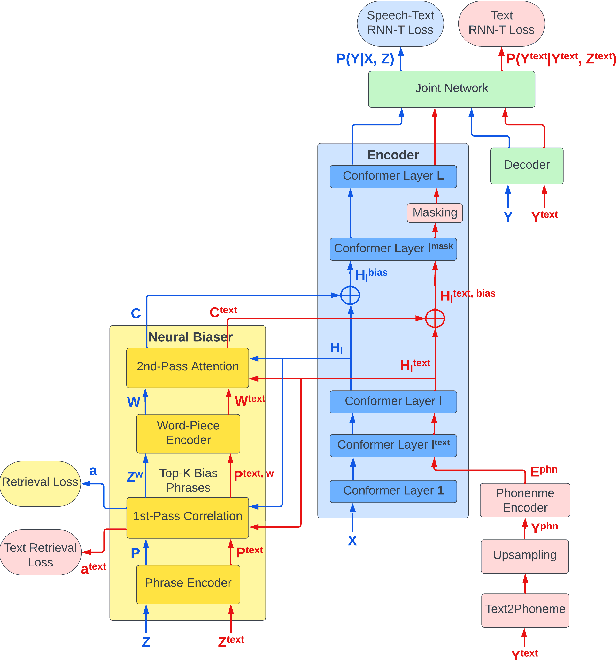
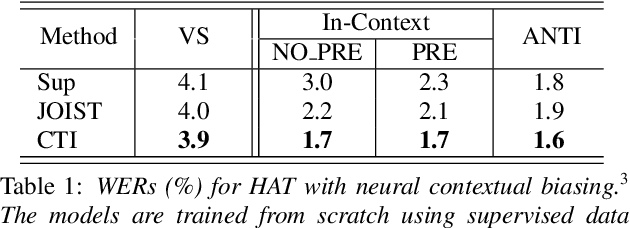
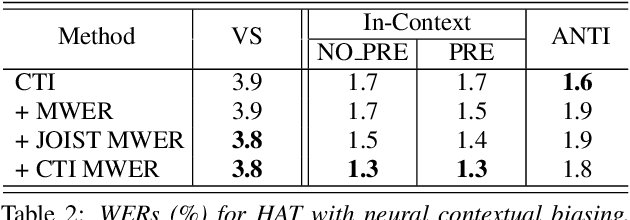

Abstract:Neural contextual biasing effectively improves automatic speech recognition (ASR) for crucial phrases within a speaker's context, particularly those that are infrequent in the training data. This work proposes contextual text injection (CTI) to enhance contextual ASR. CTI leverages not only the paired speech-text data, but also a much larger corpus of unpaired text to optimize the ASR model and its biasing component. Unpaired text is converted into speech-like representations and used to guide the model's attention towards relevant bias phrases. Moreover, we introduce a contextual text-injected (CTI) minimum word error rate (MWER) training, which minimizes the expected WER caused by contextual biasing when unpaired text is injected into the model. Experiments show that CTI with 100 billion text sentences can achieve up to 43.3% relative WER reduction from a strong neural biasing model. CTI-MWER provides a further relative improvement of 23.5%.
* 5 pages, 1 figure
Deferred NAM: Low-latency Top-K Context Injection via DeferredContext Encoding for Non-Streaming ASR
Apr 15, 2024



Abstract:Contextual biasing enables speech recognizers to transcribe important phrases in the speaker's context, such as contact names, even if they are rare in, or absent from, the training data. Attention-based biasing is a leading approach which allows for full end-to-end cotraining of the recognizer and biasing system and requires no separate inference-time components. Such biasers typically consist of a context encoder; followed by a context filter which narrows down the context to apply, improving per-step inference time; and, finally, context application via cross attention. Though much work has gone into optimizing per-frame performance, the context encoder is at least as important: recognition cannot begin before context encoding ends. Here, we show the lightweight phrase selection pass can be moved before context encoding, resulting in a speedup of up to 16.1 times and enabling biasing to scale to 20K phrases with a maximum pre-decoding delay under 33ms. With the addition of phrase- and wordpiece-level cross-entropy losses, our technique also achieves up to a 37.5% relative WER reduction over the baseline without the losses and lightweight phrase selection pass.
* 9 pages, 3 figures, accepted by NAACL 2024 - Industry Track
TransformerFAM: Feedback attention is working memory
Apr 14, 2024
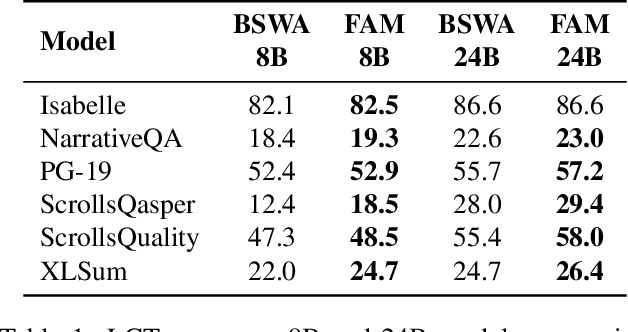

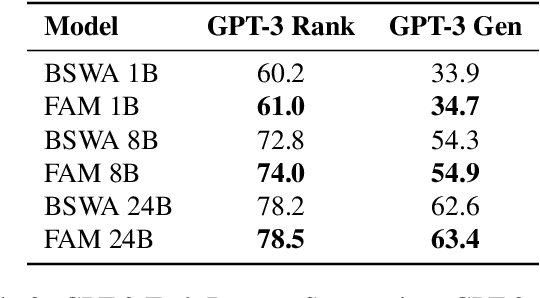
Abstract:While Transformers have revolutionized deep learning, their quadratic attention complexity hinders their ability to process infinitely long inputs. We propose Feedback Attention Memory (FAM), a novel Transformer architecture that leverages a feedback loop to enable the network to attend to its own latent representations. This design fosters the emergence of working memory within the Transformer, allowing it to process indefinitely long sequences. TransformerFAM requires no additional weights, enabling seamless integration with pre-trained models. Our experiments show that TransformerFAM significantly improves Transformer performance on long-context tasks across various model sizes (1B, 8B, and 24B). These results showcase the potential to empower Large Language Models (LLMs) to process sequences of unlimited length.
Extreme Encoder Output Frame Rate Reduction: Improving Computational Latencies of Large End-to-End Models
Feb 27, 2024Abstract:The accuracy of end-to-end (E2E) automatic speech recognition (ASR) models continues to improve as they are scaled to larger sizes, with some now reaching billions of parameters. Widespread deployment and adoption of these models, however, requires computationally efficient strategies for decoding. In the present work, we study one such strategy: applying multiple frame reduction layers in the encoder to compress encoder outputs into a small number of output frames. While similar techniques have been investigated in previous work, we achieve dramatically more reduction than has previously been demonstrated through the use of multiple funnel reduction layers. Through ablations, we study the impact of various architectural choices in the encoder to identify the most effective strategies. We demonstrate that we can generate one encoder output frame for every 2.56 sec of input speech, without significantly affecting word error rate on a large-scale voice search task, while improving encoder and decoder latencies by 48% and 92% respectively, relative to a strong but computationally expensive baseline.
USM-Lite: Quantization and Sparsity Aware Fine-tuning for Speech Recognition with Universal Speech Models
Jan 03, 2024Abstract:End-to-end automatic speech recognition (ASR) models have seen revolutionary quality gains with the recent development of large-scale universal speech models (USM). However, deploying these massive USMs is extremely expensive due to the enormous memory usage and computational cost. Therefore, model compression is an important research topic to fit USM-based ASR under budget in real-world scenarios. In this study, we propose a USM fine-tuning approach for ASR, with a low-bit quantization and N:M structured sparsity aware paradigm on the model weights, reducing the model complexity from parameter precision and matrix topology perspectives. We conducted extensive experiments with a 2-billion parameter USM on a large-scale voice search dataset to evaluate our proposed method. A series of ablation studies validate the effectiveness of up to int4 quantization and 2:4 sparsity. However, a single compression technique fails to recover the performance well under extreme setups including int2 quantization and 1:4 sparsity. By contrast, our proposed method can compress the model to have 9.4% of the size, at the cost of only 7.3% relative word error rate (WER) regressions. We also provided in-depth analyses on the results and discussions on the limitations and potential solutions, which would be valuable for future studies.
Contextual Biasing with the Knuth-Morris-Pratt Matching Algorithm
Sep 29, 2023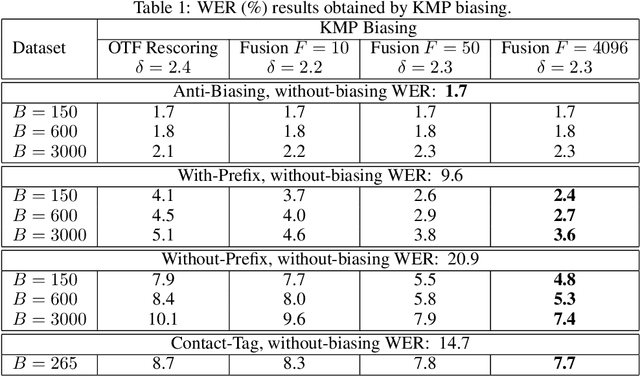
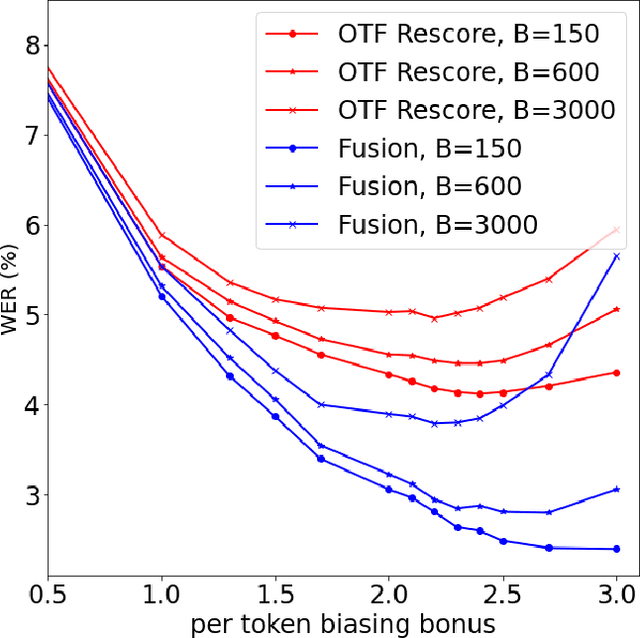
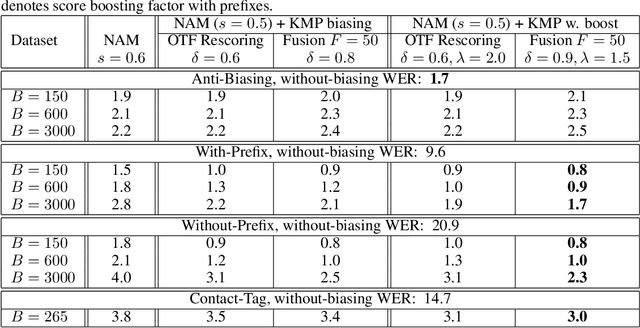
Abstract:Contextual biasing refers to the problem of biasing the automatic speech recognition (ASR) systems towards rare entities that are relevant to the specific user or application scenarios. We propose algorithms for contextual biasing based on the Knuth-Morris-Pratt algorithm for pattern matching. During beam search, we boost the score of a token extension if it extends matching into a set of biasing phrases. Our method simulates the classical approaches often implemented in the weighted finite state transducer (WFST) framework, but avoids the FST language altogether, with careful considerations on memory footprint and efficiency on tensor processing units (TPUs) by vectorization. Without introducing additional model parameters, our method achieves significant word error rate (WER) reductions on biasing test sets by itself, and yields further performance gain when combined with a model-based biasing method.
Massive End-to-end Models for Short Search Queries
Sep 22, 2023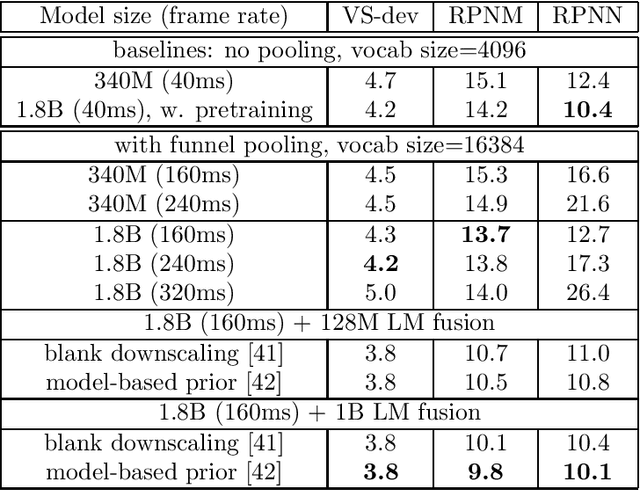
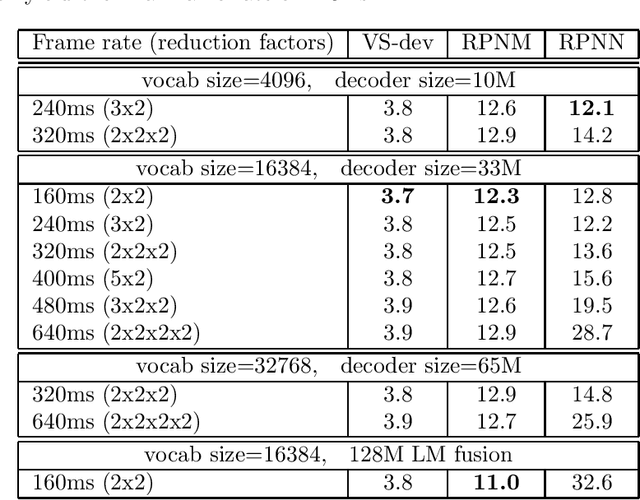
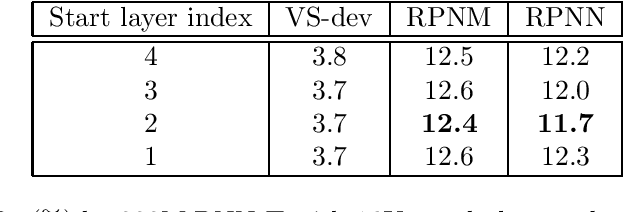
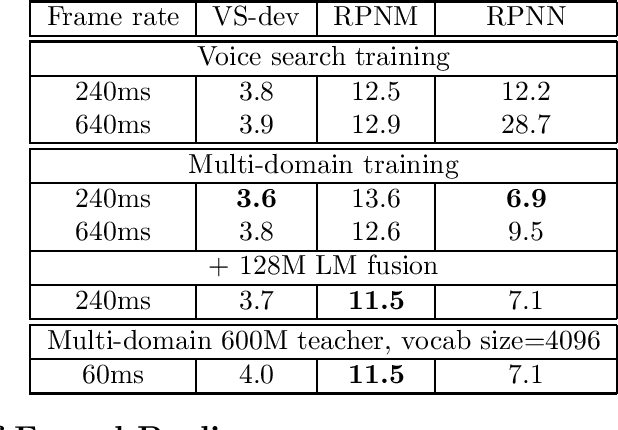
Abstract:In this work, we investigate two popular end-to-end automatic speech recognition (ASR) models, namely Connectionist Temporal Classification (CTC) and RNN-Transducer (RNN-T), for offline recognition of voice search queries, with up to 2B model parameters. The encoders of our models use the neural architecture of Google's universal speech model (USM), with additional funnel pooling layers to significantly reduce the frame rate and speed up training and inference. We perform extensive studies on vocabulary size, time reduction strategy, and its generalization performance on long-form test sets. Despite the speculation that, as the model size increases, CTC can be as good as RNN-T which builds label dependency into the prediction, we observe that a 900M RNN-T clearly outperforms a 1.8B CTC and is more tolerant to severe time reduction, although the WER gap can be largely removed by LM shallow fusion.
The Rise and Potential of Large Language Model Based Agents: A Survey
Sep 19, 2023



Abstract:For a long time, humanity has pursued artificial intelligence (AI) equivalent to or surpassing the human level, with AI agents considered a promising vehicle for this pursuit. AI agents are artificial entities that sense their environment, make decisions, and take actions. Many efforts have been made to develop intelligent agents, but they mainly focus on advancement in algorithms or training strategies to enhance specific capabilities or performance on particular tasks. Actually, what the community lacks is a general and powerful model to serve as a starting point for designing AI agents that can adapt to diverse scenarios. Due to the versatile capabilities they demonstrate, large language models (LLMs) are regarded as potential sparks for Artificial General Intelligence (AGI), offering hope for building general AI agents. Many researchers have leveraged LLMs as the foundation to build AI agents and have achieved significant progress. In this paper, we perform a comprehensive survey on LLM-based agents. We start by tracing the concept of agents from its philosophical origins to its development in AI, and explain why LLMs are suitable foundations for agents. Building upon this, we present a general framework for LLM-based agents, comprising three main components: brain, perception, and action, and the framework can be tailored for different applications. Subsequently, we explore the extensive applications of LLM-based agents in three aspects: single-agent scenarios, multi-agent scenarios, and human-agent cooperation. Following this, we delve into agent societies, exploring the behavior and personality of LLM-based agents, the social phenomena that emerge from an agent society, and the insights they offer for human society. Finally, we discuss several key topics and open problems within the field. A repository for the related papers at https://github.com/WooooDyy/LLM-Agent-Paper-List.
 Add to Chrome
Add to Chrome Add to Firefox
Add to Firefox Add to Edge
Add to Edge